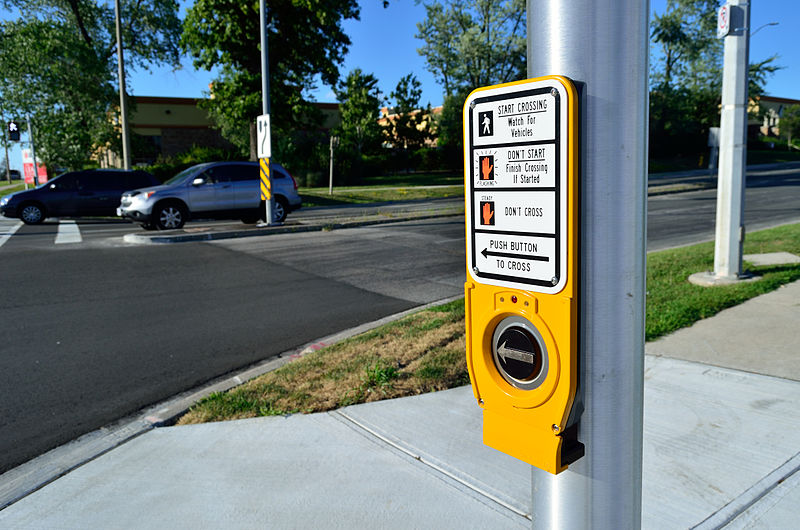By now, most of us have probably encountered an example of a pedestrian accessibility enhancement in our neighborhoods. Whether it’s a curb ramp or an audible countdown timer, these engineering and technological advancements function to make pedestrian facilities usable by people of all ages and capabilities. Many of these now-familiar advancements are a result of the Americans with Disabilities Act (ADA), which mandates that all public environments—including sidewalks and crosswalks—accommodate people with disabilities. Baseline requirements are laid out in the Public Rights of Way Accessibility Guidelines (PROWAG); PROWAG requires that pedestrian signals or warning beacons include accessible push buttons when the signal or beacon is installed or altered. However, many state and local governments have developed more stringent standards that should be referenced before undertaking a project. (In Canada, accessibility guidelines are provided by the Transportation Association of Canada, as well as individual provinces and municipalities). What follows are some of the top considerations for implementing accessible, ADA compliant crosswalks. For a complete list, please see the United States Access Board’s page on Pedestrian Street Crossings.
Want more information on Accessible Pedestrian Signals (APS) and ADA-compliant push buttons? Visit the experts at Polara Enterprises, our partner company under the Synapse ITS platform of companies.
Curb ramps
Curb ramps are required at all crossings with a change in height greater to ½ inch to provide pedestrians in wheelchairs or with other mobility restrictions a gradual entrance and exit from the crosswalk. The components of the most common type of perpendicular midblock curb ramp are labelled below. They include the ramp or ramp run (the sloped section pedestrians travel up and down), transitions (the area between the ramp and the sidewalk, as well as the ramp and the gutter), and the gutter (the roadway surface immediately next to the curb ramp that runs along the curb).  ADA requirements for curb ramps include:
ADA requirements for curb ramps include:
- 1:12 maximum running slope, or one foot in elevation change for every 12 feet
- 1:48 cross slope
- 48-inch minimum ramp width
- A level landing at top of ramp
- A clear space at the bottom outside of parallel travel lane
- Flush transitions
Detectable warnings
ADA standards require that all curb ramps include features known as “detectable warnings,” which provide a physical alert to visually impaired pedestrians that they are about to enter a roadway. These detectable warnings typically take the form of a tactile pad with small “truncated” domes that are perceptible underfoot or with a cane.  PROWAG requires that these detectable warnings:
PROWAG requires that these detectable warnings:
- Extend at least 24 inches in the direction travel
- Cover the full width of the curb ramp’s flush edge
- Are placed at the back of curb or at grade break
- Have truncated domes with a diameter of 0.9” at the bottom, a diameter of 0.4” at the top, and height of 0.2”
- Have high visual contrast with surrounding surfaces
Pushbuttons
Pedestrian pushbutton requirements can be found in the MUTCD and PROWAG. The most recent PROWAG proposed accessibility guidelines require all new and altered pedestrian signals to include the following features:
- Be a minimum of 2 inches across in at least one dimension
- Be operable with a closed fist
- Be operable with a force no greater that 3.5 pounds
- A visual contrast with the background of at least 70%
- An audible locator tone that informs pedestrians of the need to push a button and provides an audible cue to the location of the button
- A visible and audible indicator that the button has been pressed
 The MUTCD also provides additional guidance on the location of pushbuttons, including:
The MUTCD also provides additional guidance on the location of pushbuttons, including:
- Between 1.5 and 6 feet from the edge of the curb, shoulder, or pavement
- Within 5 feet of the crosswalk line
- At a mounting height of approximately 3.5 feet, but no more than 4 feet, above the sidewalk
- Face of pushbutton must be parallel to the crosswalk
Additional considerations
There are a number of other considerations that are not covered by this article, including crosswalk marking materials (X02.5.4.4) , extended crossing times (X02.5.5), and medians and pedestrian refuge islands (X02.5.6)—enhancements that benefit not only people with disabilities but everyone looking to get to and from their destination safely. For more information and guidance on these topics and others, please refer to the United State’s Access Board’s Pedestrian Street Crossings page. And if you’re looking to learn more about our crosswalk solutions, please click the button below, or get in touch with our sales team.
